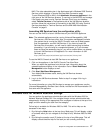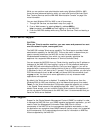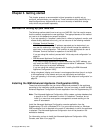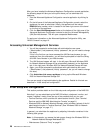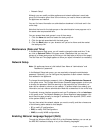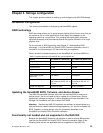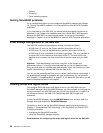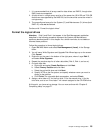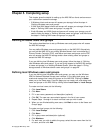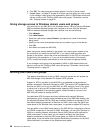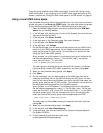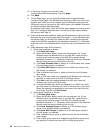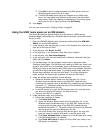
v Failover
v Clustering
v Other operating systems
Solving ServeRAID problems
For a complete description of how to diagnose ServeRAID problems see Chapter
18, “Solving ServeRAID problems” in the ServeRAID-4x Ultra160 SCSI Controller
publication.
If you need help on your NAS 200, you should follow the support instructions as
described in the Storage Unit Installation and User’s Guide GA27-4259 appendix.
Because the NAS 200 is a preconfigured system, do not use the information
described in Chapter 19 of the ServeRAID-4x Ultra160 SCSI Controller publication.
Initial storage configuration of the NAS 200
The NAS 200 comes with preconfigured storage, formatted as follows:
v A RAID-level 1E array, for the System partition (drive letter will be C:)
v A RAID-level 1E array, for the Maintenance partition (drive letter will be D:)
v A RAID-level 5 array, comprised of the remaining storage. This array consists of
a single LUN, for the Data drive (drive letter will be E). The size of this LUN
depends on the number and size of hard disk drives that came with your NAS
200.
Attention: Note that although you will be using files in the System and
Maintenance drives, it is strongly recommended that you do not repartition them.
Doing so could wipe out important data and seriously impair the functioning of your
system. Repartitioning is advised ONLY for the Data drive.
You can use the preconfigured Data drive, or delete it and configure new storage. If
the preconfigured storage is agreeable with your requirements, you can proceed
with “Chapter 5. Completing setup” on page 27. If you delete the Data drive, you will
need to complete the steps in this chapter.
Creating arrays and logical drives
You configure RAID disk arrays and logical drives on your NAS 200 using the
ServeRAID Manager. With ServeRAID Manager, you can configure and manage the
storage mounted in the NAS 200 itself (the internal hard disk drives), in addition to
the storage mounted in any IBM 5194 TotalStorage NAS 200 Storage Unit
enclosures.
To start ServeRAID Manager, click the IBM NAS Admin icon, and then open the
Storage folder and double-click ServeRAID Manager.
For details on how to use the ServeRAID Manager, see the following sections in
Chapter 4, “Understanding RAID technology” in the ServeRAID-4x Ultra160 SCSI
Controller publication:
v Configuring the ServeRAID controller
v Using the ServeRAID manager program
Considerations for configuring the arrays and logical drives for the NAS 200:
24 NAS 200 User’s Reference




